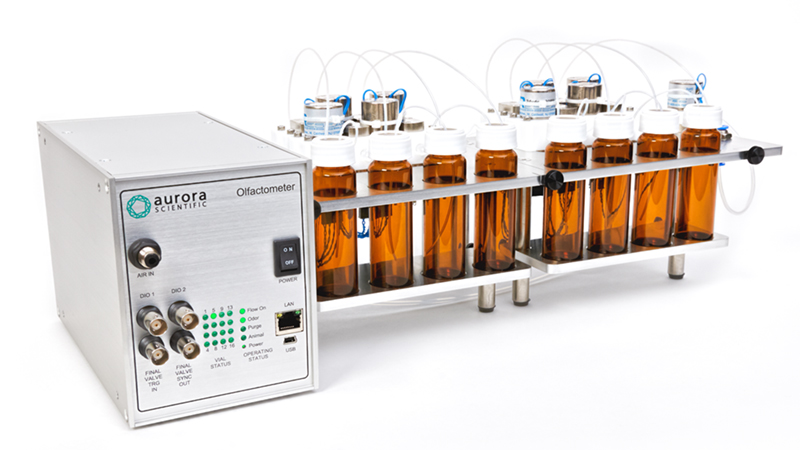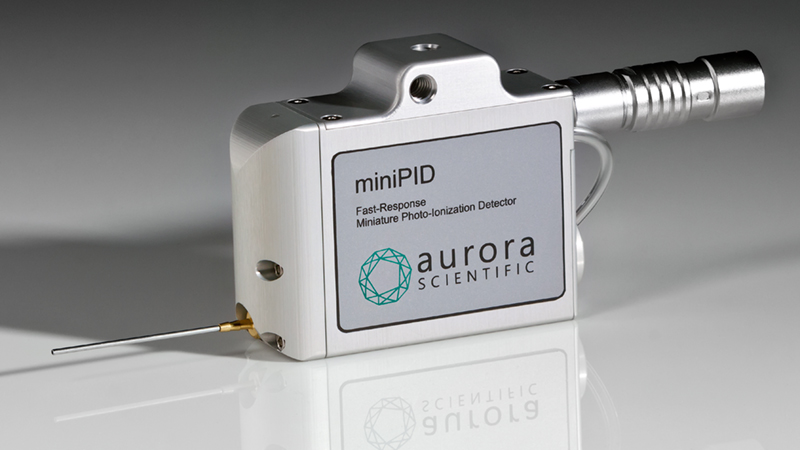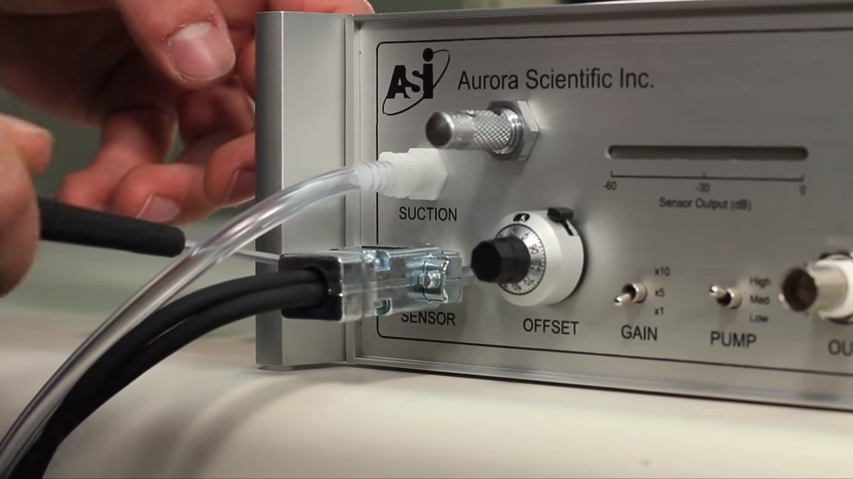There is a new version of this product available. Check out the 200C: miniPID Fast Response Olfaction Sensor!
200B: miniPID Fast Response Olfaction Sensor
The 200B miniPID photo-ionization detector combines small size, fast response, and high sensitivity in an easy-to-use, competitively priced package. Designed for olfaction experiments, the sensor has a true frequency response of 330 Hz with a rise time of 0.6 msec. The detection limit is 100 ppb (parts per billion) propylene in air and the full-scale measurement range is 500 ppm.
The miniPID has been used successfully for numerous olfaction studies involving mice, rats, Drosophila, moths, mosquitos and ants. Researchers and manufacturers have also been using the miniPID to characterize olfactometers.
The sensor head contains the detection cell, electrometer, RF-excited UV lamp and lamp control circuitry. The easy-to-use controller has switches for instrument power, pump speed and gain, and a control for setting the zero. LEDs provide indication of power, pump, and lamp status. A front-panel display provides fast-response indication of the output signal from the sensor.
Sensor
Controller
Variants
201A Portable, Battery Powered miniPID Sensor:
Portable, battery powered miniPID sensor ideal for use on moving platforms such as robots
Optional Support Equipment
- calibration kit
- data acquisition system
- tracer gas release system
Stories of Success
200B – Modeling Insect Pheromone Tracking
CHALLENGE
In 2008 Dr. Willis from Case Western Reserve University wanted to use mobile wheeled robots to serve as hardware models to test hypotheses on how insects control their odor tracking behavior. He had done work with small 2D robots in the wind tunnel but now wanted to move to the unpredictable real world environments outdoors. For this work he required two fast response gas sensors that were small enough to mount on the robot. The sensors also had to be battery operated as the robot would not be tethered.
SOLUTION
Aurora Scientific’s R&D team knew that the miniPID sensor head met most of Dr. Willis’ requirements but the controller was too large, too heavy and required AC power. A new battery powered controller was designed that was small and light enough to be deployed on the robot. The new controller was powered by two NiMH batteries which provided about 2 hours of continuous operation. Changes were also made to the sensor to allow it to be easily mounted to the robot. This involved removing the long mounting rod, removing the sensor connector and replacing it with a short length of wires that plugged directly into the controllers. The cover on the side of the sensor head was also modified to provide a simple clamp mechanism for holding the sensor onto the robot.
RESULTS
Two sensors were built and supplied to Dr. Willis. Our modifications allowed them to be securely mounted on the robot and preliminary tests were conducted. In 2014 Dr. Willis reported that the battery powered controllers were failing and asked for them to be repaired. We took this opportunity to redesign and repackage the controllers and to also redesign the battery packs. We supplied him with two instruments of the new design. The new design uses Lithium-ion batteries which are smaller, lighter and last about twice as long, which have provided Dr. Willis with reliable and portable equipment to model insect pheromone tracking in real world environments. In addition, the new design is now available as the model 201A portable miniPID.
Select References
- Perl et al. “The contribution of temporal coding to odor coding and odor perception in humans” eLife (2020) DOI: 10.7554/eLife.49734
- Petelski et al. “Synergistic olfactory processing for social plasticity in desert locusts” Nature Communications (2024) DOI: 10.1038/s41467-024-49719-7
- Nagel, Katherine I., Elizabeth J. Hong and Rachel Wilson. “Synaptic and circuit mechanisms promoting broadband transmission of olfactory stimulus dynamics.” Nature Neuroscience (2015) DOI: 10.1038/nn.3895
- True et al. “Structure of dense plumes from a finite-height cylinder in laminar crossflow” Environmental Fluid Mechanics (2024) DOI: 10.1007/s10652-024-10006-0
- Barta et al. “Stimulus duration encoding occurs early in the moth olfactory pathway” Communications biology (2024) DOI: 10.1038/s42003-024-06921-z
- Lehmann et al. “SNMP1 is critical for sensitive detection of the desert locust aromatic courtship inhibition pheromone phenylacetonitrile” BMC Biology (2024) DOI: 10.1186/s12915-024-01941-x
- Ohla, Kathrin and Johan N. Lundström. “Sex differences in chemosensation: sensory or emotional?” Frontiers in Human Neuroscience (2013) DOI: 10.3389/fnhum.2013.00607
- Schoonover et al. “Representational drift in primary olfactory cortex” Nature (2021) DOI: 10.1038/s41586-021-03628-7
- Schoonover et al. “Representational drift in primary olfactory cortex” Nature (2021) DOI: 10.1038/s41586-021-03628-7
- Bhattacharjee et al. “Quantitative assessment of olfactory dysfunction accurately detects asymptomatic COVID-19 carriers” EClinical Medicine (2020) DOI: 10.1016/j.eclinm.2020.100575
Related Products

220A: Olfactometer
The 220A Olfactometer provides reliable odor generation for demanding olfaction experiments.
Learn MoreSpecifications
| 200B | 201A | |
|---|---|---|
| Detection Limit [ppb (propylene)] | 50.0 | 50.0 |
| Operating Concentration Range [ppm] | Gain 1X: 0-625 Gain 5X: 0-125 Gain 10X: 0-60 |
Gain 1X: 0-625 N/A Gain 10X: 0-60 |
| Frequency Response1 [Hz] | 330 | 330 |
| Precision [%] | 5 (all gain ranges) | 5 (all gain ranges) |
| Sampling Flowrate [sccm2] | High: 1500 Med: 1200 Low: 900 |
1500 |
| Suction Inlet Tube Diameter [mm] | 0.84 | 0.84 |
1 = -3dB point; 2 = Standard cubic centimeters per minute
| General Specifications | 200B | 201A |
|---|---|---|
| Detector Technology | Photoionization | Photoionization |
| Lamp Type | 10.6 eV, RF-excited UV Electrodeless Discharge | 10.6 eV, RF-excited UV Electrodeless Discharge |
| Operating Temperature [°C] | 0 – 40 | 0 – 40 |
| Operating Humidity [%RH] | 0 to 100 (non-condensing) | 0 to 100 (non-condensing) |
| Power Required | 100, 120, 220, 240 VAC, 50/60 Hz. available | ±18 VDC (Li-Ion Battery) |
| Power Consumption [W] | 20 | 20 |
| Controller Weight [kg] | 3.1 | 1.1 |
| Head Weight [g] | 170 | 170 |
| Head Dimensions [cm] | 2.5W x 7.6L x 5.1H | 2.5W x 7.6L x 5.1H |
| Controller Dimensions [cm] | 21W (1/2 rack mount) x 25D x 9H (2U) | 11W (1/4 rack mount) x 15D x 4.4H (1U) |
| Battery Dimensions [cm] | N/A | 11W (1/4 rack mount) x 15D x 4.4H (1U) |



